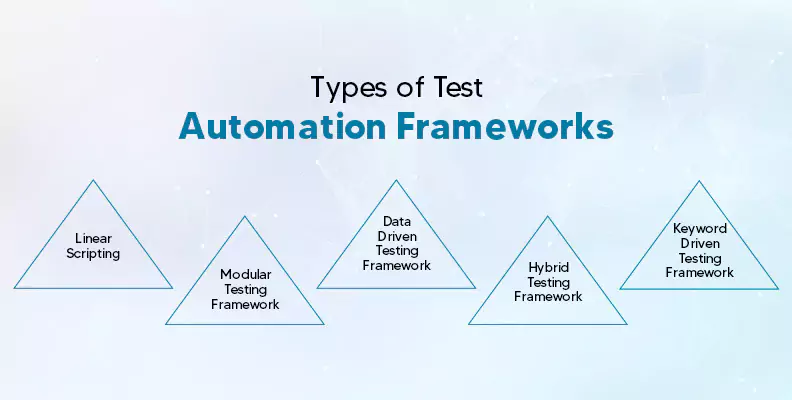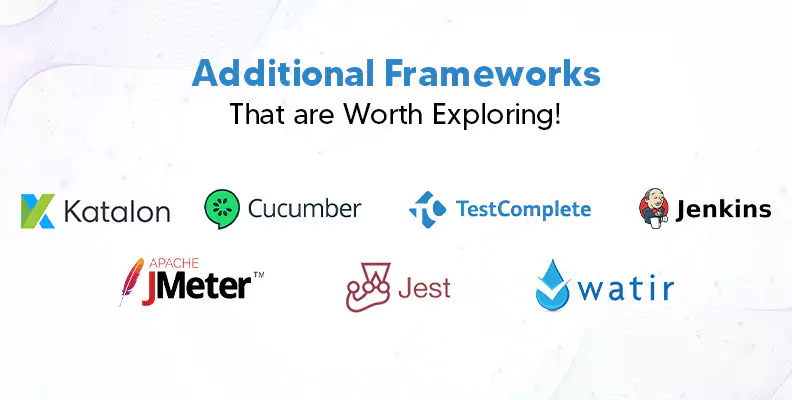Loading.....
Choosing the Right Automation Testing Framework for Your Project
In the dynamic realm of software development and testing, selecting the right automation testing tool is pivotal for ensuring the success of your project. This comprehensive guide is designed to be your compass through this decision-making process, dissecting the crucial steps in a manner that is easily comprehensible and customised to meet the specific needs of your project. Let's explore together and discover the ideal tool to elevate your software testing to new heights!
How do I choose a test automation tool?

Selecting a test automation tool is a strategic process that involves careful consideration of various factors. Here are the key considerations:
-
Define Project Requirements:
- Gain a profound understanding of your project's nature and testing needs.
- Identify the specific types of testing required, such as functional, regression, performance, and more.
-
Compatibility with Technology Stack:
- Ensure the selected tool aligns seamlessly with your application's technology stack.
- Consider cross-browser and cross-platform testing requirements to guarantee comprehensive coverage.
-
Ease of Integration:
- Opt for a tool that effortlessly integrates into your development environment.
- Verify compatibility with popular Continuous Integration (CI) tools and version control systems for streamlined collaboration.
-
Learning Curve:
- Assess the learning curve associated with each tool.
- Choose a tool that complements your team's expertise or offers a swift learning curve for efficient adoption.
-
Community Support:
- Consider the tool's community support and the availability of comprehensive documentation.
- An active and engaged community often indicates ongoing development and timely issue resolution.
What are Test Automation Frameworks?
Test automation frameworks serve as structured guidelines for creating and organizing automated tests. Let's delve into the various types:
Types of Test Automation Frameworks

-
Linear Scripting (Linear Framework):
- Characteristics: Sequential execution of test cases.
- Suitable For: Small projects with straightforward test cases.
-
Modular Testing Framework:
- Characteristics: Breaks down test scripts into smaller, manageable modules.
- Suitable For: Projects with complex functionalities requiring independent testing.
-
Data-Driven Testing Framework:
- Characteristics: Separates test data from test scripts, allowing easy modification.
- Suitable For: Scenarios requiring the same test script with multiple sets of data.
-
Keyword-Driven Testing Framework:
- Characteristics: Uses keywords to represent operations, promoting collaboration between technical and non-technical team members.
- Suitable For: Collaboration-heavy projects with cross-functional teams.
-
Hybrid Testing Framework:
- Characteristics: A combination of two or more testing frameworks.
- Suitable For: Versatile projects with varying testing requirements.
Best Test Automation Frameworks
Choosing the best test automation framework hinges on your project's specific needs. Here's an in-depth look at some widely used frameworks, each excelling in specific areas:
-
Selenium WebDriver:
- Features: Open-source, supports multiple programming languages.
- Best For: Web application testing.
- Strengths: Selenium WebDriver is renowned for its versatility and robust support for various browsers and platforms.
-
Appium:
- Features: Open-source, cross-platform (supports Android and iOS).
- Best For: Mobile application testing.
- Strengths: Appium's cross-platform capabilities make it an excellent choice for testing mobile applications on both Android and iOS devices.
-
JUnit and TestNG:
- Features: Java-based, widely used for unit testing.
- Best For: Java projects.
- Strengths: JUnit and TestNG are highly popular for unit testing in Java projects, providing extensive support for test organization and execution.
-
Cypress:
- Features: JavaScript-based, designed for simplicity and speed.
- Best For: Front-end testing.
- Strengths: Cypress stands out for its speed and efficiency in front-end testing, offering real-time feedback during test execution.
-
Robot Framework:
- Features: Keyword-driven, supports acceptance test-driven development (ATDD).
- Best For: Acceptance testing.
- Strengths: Robot Framework's keyword-driven approach simplifies test creation, making it ideal for acceptance testing scenarios.
Additional Frameworks That Are Worth Exploring!

-
JMeter:
- Best For: Performance Testing and Load Testing
- Strengths: As a versatile open-source tool, JMeter supports diverse protocols, making it ideal for scalable performance and load testing. It provides comprehensive test reporting for in-depth analysis.
-
TestComplete:
- Best For: Cross-platform testing
- Strengths: Supports various scripting languages, powerful object recognition, and easy integration.
-
Cucumber:
- Best For: Behavior-Driven Development (BDD)
- Strengths: Cucumber facilitates collaboration between technical and non-technical team members. Its Gherkin syntax promotes the creation of readable test cases, fostering effective Behavior-Driven Development.
-
Katalon Studio:
- Best For: Web, mobile, and API testing
- Strengths: Built-in keywords, record and playback, and user-friendly interface.
-
Jenkins:
- Best For: Continuous Integration and Continuous Delivery (CI/CD)
- Strengths: Jenkins excels in automating build, test, and deployment processes. With extensive plugin support and robust CI/CD pipelines, it streamlines software delivery.
-
Jest:
- Best For: React and JavaScript projects
- Strengths: Snapshot testing, zero-configuration, and parallel test execution.
-
Watir:
- Best For: Web application testing with Ruby
- Strengths: Ruby language, cross-browser support, and intuitive element interaction.
Explore these frameworks based on your project's needs for efficient, reliable, and streamlined test automation.
Conclusion
In conclusion, the selection of the right automation testing framework involves a meticulous evaluation of project requirements, tool compatibility, ease of integration, learning curve, and community support. Your choice of framework should align with the nature of your project and the types of testing required.
Remember, the best framework is the one that aligns with your team's expertise and your project's specific needs. Whether it's Selenium WebDriver for web applications, Appium for mobile testing, or JUnit/TestNG for Java projects, the key is to match the tool's strengths with your project's requirements.
This guide aims to empower you with the knowledge needed to make an informed decision when choosing an automation testing framework. Happy testing! 🚀
 Back to blog
Back to blog












